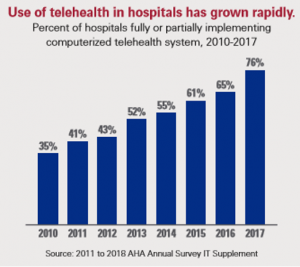The recent struggles of former talk show host Wendy Williams have brought significant attention to the complexities and potential pitfalls of guardianship arrangements.

Telehealth has become Increasingly Popular with the Senior Population
Through the use of remote health tech monitoring and videoconferencing over wireless devices, telehealth can connect patients to vital health care services. According to the American Hospital Association (AHA), fully 76 percent of US hospitals are using some form of telehealth for their patient groups.

During this COVID-19 pandemic, the federal government has freed up some regulations that previously stifled telehealth practices by increasing Medicare coverage allowances as well as permitting doctors to practice over state lines, further increasing telehealth demand. This unprecedented surge in patients is stressing major telehealth providers’ technical infrastructure as well as the availability of physicians, physician assistants, and registered nurses who can deliver accredited virtual care. Huge backlogs are becoming the norm as telehealth ready hospitals and other facilities scramble to meet the demand.
Addressing the incoming demand is not that easy as major health systems like the Cleveland Clinic are experiencing a fifteen-fold increase in telehealth visits per week, and that number is likely to increase. For those lacking standard internet connectivity, doctors are expanding phone consultations and recording videos as telehealth services increase asynchronous connection capability to address rural patients lacking reliable broadband capability for health services during this pandemic. The Cleveland Clinic also has a health bot (an automated online interactive chat window) COVID-19 risk assessment available on its home page where you can follow the prompts to determine your risk level for coronavirus based on your given answers. The University of Pennsylvania (Penn Medicine) is receiving virtual health care requests faster than clinicians can respond to them even though the hospital’s daily consultations have gone from 6 to 60 online appointments. Hospitals across the country are experiencing a similar explosion in the number of telehealth requests.
Many Americans do not seem to be fully satisfied with gathering their information about COVID-19 on websites such as the Centers for Disease Control and Prevention and the World Health Organization. Instead, they are opting for more personalized contact via a telehealth provider, which may be decreasing fear levels more than providing additional insights as medical personnel uses the guidelines established by these reliable health organizations.
The telehealth service sector is hoping that the coronavirus pandemic demonstrates the value of remote health services resulting in an enduring shift to its delivery mechanism in the future. Even when stretched beyond full capacity, telehealth allows the pooling of health care resources and delivery of them to where they are most needed. Though not currently operating to its full potential, telehealth during the time of the coronavirus pandemic remains one of the safest ways to receive medical attention and advice.
We encourage you to reach out to your medical provider to determine whether telehealth is an option should you need medical attention. It is a much safer way to talk to a health care specialist and determine what type of treatment you may need.
Please contact our Houston office today or schedule a consultation to discuss your legal matters. We would be happy to help you and welcome your call.

